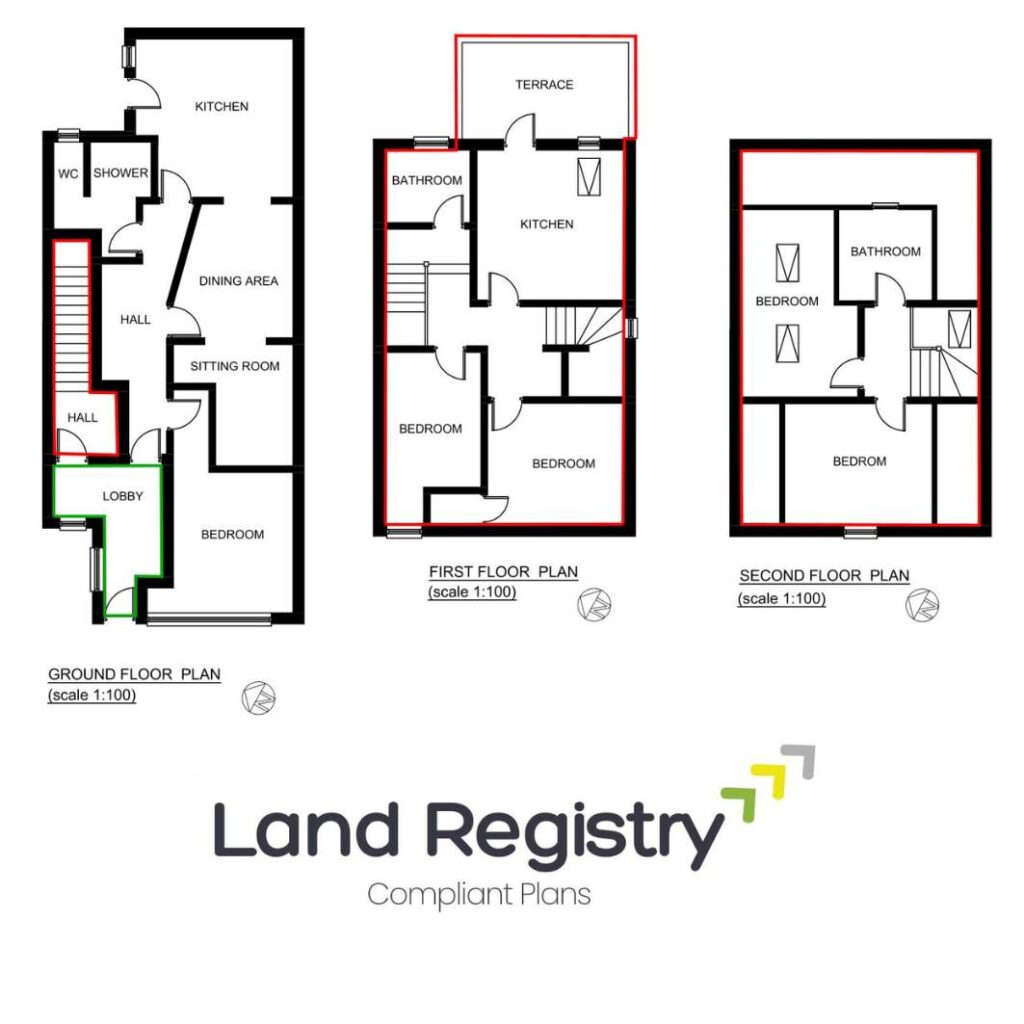The Land Registry Hub: Your Go-To Guide for Property Plans & Conveyancing
🛠️ Navigating the world of Land Registry, lease plans, title plans, and conveyancing can feel like a legal maze—but don’t worry, we’ve got you covered! Whether you’re a property owner, landlord, solicitor, or just someone trying to make sense of UK property rules, this blog is your one-stop resource for clear, practical advice.
From understanding lease plans to avoiding common conveyancing pitfalls, we break it all down in a way that’s easy to follow. Stay tuned for expert insights, tips, and updates to keep you ahead in the property game! 🏡📜✨

Land Registry Compliant Plans
The Role of Conveyancing Plans in Property Transactions: A Complete Guide
If you’ve ever bought, sold, or leased a property in the UK, you’ve probably heard the term conveyancing plans thrown around. But what exactly are they, and why are they so important?
Conveyancing plans are vital documents used in property transactions, ensuring that everyone involved—buyers, sellers, solicitors, and the Land Registry—knows exactly what’s included in the deal. Whether you’re transferring ownership, registering a lease, or dealing with boundary issues, having an accurate conveyancing plan can save you from legal headaches and delays.
So, let’s break it all down: What is a conveyancing plan, why do you need one, and how do you make sure it’s correct?
What is a Conveyancing Plan?
A conveyancing plan is a scaled drawing that shows the precise boundaries and layout of a property or land being transferred or registered. It typically includes:
✅ Property boundaries (marked clearly in red)
✅ Land ownership details (including freehold and leasehold areas)
✅ Rights of way and easements (like shared access, driveways, or pathways)
✅ Any restrictions (such as no-build zones or conservation areas)
It serves as a visual confirmation of what’s being bought, sold, or leased—reducing confusion and ensuring everything is legally sound.
Why Are Conveyancing Plans Important?
Conveyancing plans aren’t just an extra piece of paperwork—they play a key role in making property transactions smooth and legally compliant.
1️⃣ They Define Exactly What’s Being Transferred
Ever heard of boundary disputes? They’re more common than you’d think. A clear conveyancing plan ensures there’s no confusion over what land is included in a sale or lease.
2️⃣ Required for Land Registry Applications
If you’re registering a property for the first time or updating details, the Land Registry may require a compliant conveyancing plan. Without it, your application could be delayed or rejected.
3️⃣ Helps with Leasehold Properties
For leases over seven years, a Land Registry-compliant lease plan is legally required. This is a specific type of conveyancing plan showing the leased area and any shared access.
4️⃣ Essential for Splitting or Merging Land Titles
If you’re dividing a large property into smaller units (e.g., converting a house into flats) or combining multiple properties into one title, a conveyancing plan is a must.
5️⃣ Used in Property Development & Planning Applications
If you’re developing land or applying for planning permission, local authorities may need conveyancing plans to assess property boundaries and restrictions.
Types of Conveyancing Plans
Not all conveyancing plans are the same. The type of plan you need depends on your specific property transaction.
📌 Title Plans
A title plan shows the general boundaries of a property as registered with the HM Land Registry. It’s used in property sales and ownership transfers.
📌 Lease Plans
A lease plan is required when registering a lease of seven years or more. It outlines the exact area being leased, including any shared spaces.
📌 Transfer Plans
Used when part of a property is being sold or transferred (e.g., selling a section of your garden). It must show new boundaries clearly.
📌 Boundary Plans
If there’s a dispute over land ownership, a boundary plan can help clarify where one property ends and another begins.
What Makes a Conveyancing Plan Land Registry Compliant?
To be accepted by HM Land Registry, a conveyancing plan must meet strict criteria. Here’s what you need to check:
✅ Correct Scale & Orientation
- 1:1250 for urban areas
- 1:2500 for rural areas
- Must include a north point
✅ Clearly Defined Boundaries
- Property boundaries outlined in red
- Any shared areas or rights of way must be clearly marked
✅ Accurate Positioning
- The plan should be based on Ordnance Survey mapping
- It should match the property’s registered title
✅ All Relevant Features Included
- Buildings, roads, pathways, gardens, and any rights of way
- If there are restrictions (e.g., conservation areas), they must be noted
Common Mistakes That Can Cause Delays
🚨 Mistake 1: Incorrect or Missing Boundaries
If the boundaries aren’t properly marked, your plan might be rejected—or worse, it could lead to ownership disputes later on.
🚨 Mistake 2: Using the Wrong Scale
If your plan isn’t drawn to the correct scale, it won’t be accepted by the Land Registry.
🚨 Mistake 3: Failing to Show Rights of Way
If a property has shared access (like a driveway or communal garden), it must be marked—otherwise, future disputes could arise.
🚨 Mistake 4: Poor Quality or Illegible Plans
Blurry, unclear, or hand-drawn plans won’t be accepted—they must be professionally prepared.
How to Get a Compliant Conveyancing Plan
If you need a conveyancing plan, the best way to ensure it’s correct is to have it professionally drawn up. Here’s how:
Step 1️⃣ Hire a Professional
A chartered surveyor, property lawyer, or specialist mapping company can create a compliant plan for you.
Step 2️⃣ Verify the Plan Against Ordnance Survey Maps
To ensure accuracy, your plan should be based on the latest OS mapping.
Step 3️⃣ Double-Check for Missing Features
Make sure all boundaries, rights of way, and access points are clearly marked.
Step 4️⃣ Submit in the Correct Format
The Land Registry prefers PDF or printed plans with high resolution.
What to Do If Your Conveyancing Plan Is Rejected?
If the Land Registry rejects your conveyancing plan, don’t panic! Here’s what you need to do:
📌 Check the rejection notice – It will specify the issue.
📌 Consult a professional – A surveyor or solicitor can correct the errors.
📌 Make the necessary changes and resubmit the plan.
A small mistake can cause unnecessary delays, so always double-check before submitting!
Final Thoughts: Don’t Underestimate the Importance of a Conveyancing Plan
A properly prepared conveyancing plan can save you time, money, and legal headaches. Whether you’re buying, selling, leasing, or resolving a boundary issue, making sure your plan is Land Registry compliant is essential.
If you’re unsure whether you need a conveyancing plan, speak to a professional surveyor or property solicitor—they’ll guide you through the process and ensure everything is done correctly from the start.
💬 Got questions about conveyancing plans? Drop them in the comments—we’re happy to help! 🏡📜✨
Contact Us
Call Us : 01375 267 277
We are open from Monday to Friday
08.30 AM - 17.30 PM
Surv Essex Limited
Building 13 Thames Enterprise Centre
Princess Margaret Road
East Tilbury
RM18 8RH
Our Services
- Lease Plans
- Title Plans
- Conveyancing Plans
- Licencing Plans
- Retail Plans
Quick Links
- Home
- About Us
- Pricing Plan
- Team
- Blog
- Privacy Policy
- Terms & Service

